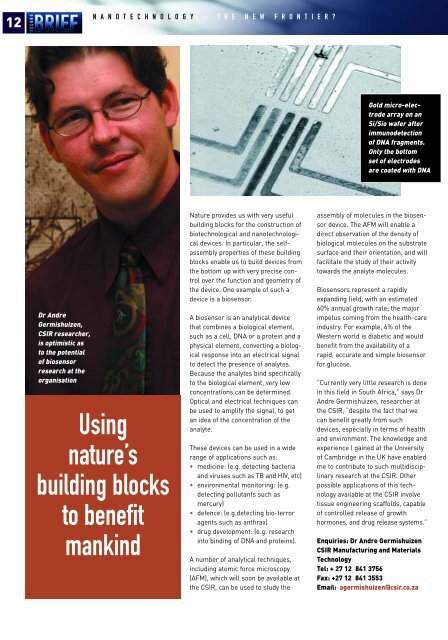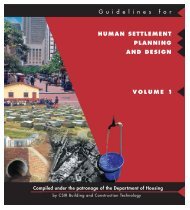January / February 2005 - CSIR
January / February 2005 - CSIR
January / February 2005 - CSIR
- No tags were found...
Create successful ePaper yourself
Turn your PDF publications into a flip-book with our unique Google optimized e-Paper software.
12N A N O T E C H N O L O G Y – T H E N E W F R O N T I E R ?Gold micro-electrodearray on anSi/Sio wafer afterimmunodetectionof DNA fragments.Only the bottomset of electrodesare coated with DNADr AndreGermishuizen,<strong>CSIR</strong> researcher,is optimistic asto the potentialof biosensorresearch at theorganisationUsingnature’sbuilding blocksto benefitmankindNature provides us with very usefulbuilding blocks for the construction ofbiotechnological and nanotechnologicaldevices. In particular, the selfassemblyproperties of these buildingblocks enable us to build devices fromthe bottom up with very precise controlover the function and geometry ofthe device. One example of such adevice is a biosensor.A biosensor is an analytical devicethat combines a biological element,such as a cell, DNA or a protein and aphysical element, converting a biologicalresponse into an electrical signalto detect the presence of analytes.Because the analytes bind specificallyto the biological element, very lowconcentrations can be determined.Optical and electrical techniques canbe used to amplify the signal, to getan idea of the concentration of theanalyte.These devices can be used in a widerange of applications such as:• medicine: (e.g. detecting bacteriaand viruses such as TB and HIV, etc)• environmental monitoring: (e.g.detecting pollutants such asmercury)• defence: (e.g.detecting bio-terroragents such as anthrax)• drug development: (e.g. researchinto binding of DNA and proteins).A number of analytical techniques,including atomic force microscopy(AFM), which will soon be available atthe <strong>CSIR</strong>, can be used to study theassembly of molecules in the biosensordevice. The AFM will enable adirect observation of the density ofbiological molecules on the substratesurface and their orientation, and willfacilitate the study of their activitytowards the analyte molecules.Biosensors represent a rapidlyexpanding field, with an estimated60% annual growth rate; the majorimpetus coming from the health-careindustry. For example, 6% of theWestern world is diabetic and wouldbenefit from the availability of arapid, accurate and simple biosensorfor glucose.“Currently very little research is donein this field in South Africa,” says DrAndre Germishuizen, researcher atthe <strong>CSIR</strong>, “despite the fact that wecan benefit greatly from suchdevices, especially in terms of healthand environment. The knowledge andexperience I gained at the Universityof Cambridge in the UK have enabledme to contribute to such multidisciplinaryresearch at the <strong>CSIR</strong>. Otherpossible applications of this technologyavailable at the <strong>CSIR</strong> involvetissue engineering scaffolds, capableof controlled release of growthhormones, and drug release systems.”Enquiries: Dr Andre Germishuizen<strong>CSIR</strong> Manufacturing and MaterialsTechnologyTel: + 27 12 841 3756Fax: +27 12 841 3553Email: agermishuizen@csir.co.za
















